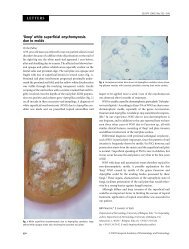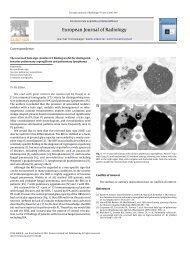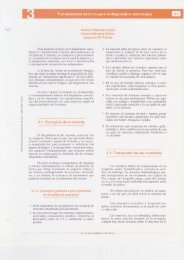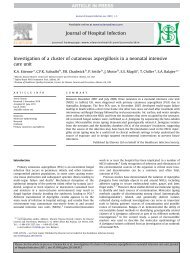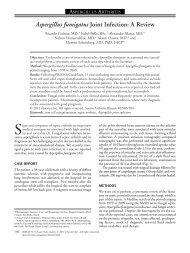Canine Chronic Inflammatory Rhinitis
Canine Chronic Inflammatory Rhinitis
Canine Chronic Inflammatory Rhinitis
Create successful ePaper yourself
Turn your PDF publications into a flip-book with our unique Google optimized e-Paper software.
<strong>Canine</strong> chronic inflammatory rhinitis 77<br />
with LPR may provide valuable information on the role of this<br />
organism in the syndrome.<br />
Table 1 Common Clinical Signs in 37 Dogs with Idiopathic<br />
<strong>Rhinitis</strong> 5<br />
Secondary Infection<br />
Secondary bacterial infection is common in dogs with<br />
chronic nasal disease, which may explain the transient response<br />
to antibiotics seen in some dogs with LPR. Nasal<br />
cultures from dogs with LPR yield mixed bacterial growth of<br />
normal nasal flora including Staphylococcus, Streptococcus,<br />
Escherichia coli, Proteus, Pasteurella, Corynebacterium, Bordetella,<br />
and Pseudomonas. 5-7 A recent study demonstrated no<br />
significant difference in bacterial DNA loads among dogs<br />
with LPR, fungal rhinitis, and nasal neoplasia; however, all<br />
three disease groups had significantly higher bacterial loads<br />
than did healthy control dogs. 4 Accumulation of bacterial<br />
organisms in dogs with chronic nasal disease could result<br />
from mucus trapping and decreased nasal mucosal defense<br />
mechanisms.<br />
Role of Fungal Organisms<br />
Aspergillus and Penicillium spp. are common inhabitants of<br />
the canine nasal cavity, 6 and a positive fungal culture can be<br />
found in the absence of primary fungal rhinitis. Candida,<br />
Trichosporum, and Cladosporidium have also been cultured<br />
from dogs with LPR. 5 In the study assessing molecular con -<br />
tent of paraffin-embedded nasal tissue from dogs, higher fungal<br />
DNA loads were reported in dogs with LPR than in<br />
healthy control dogs and dogs with nasal neoplasia. 4 Mucus<br />
trapping and decreased nasal defense mechanisms alone cannot<br />
explain this difference because dogs with nasal neoplasia<br />
would be expected to have similar mucosal compromise to<br />
dogs with LPR. Further research is required to determine the<br />
significance of increased fungal DNA in dogs with LPR. Fungal<br />
hypersensitivity characterized by an aberrant immune<br />
response has been identified in human chronic rhinosinusitis<br />
(CRS) patients. 8-14 Humans with CRS exhibit a humoral and<br />
cellular (Th1 and Th2) response to airborne fungi. 8 T-cell<br />
sensitization to fungus leads to production of T-helper 2<br />
cytokine release, namely Interleukin-5. 11 Fungal hypersensitivity<br />
in humans appears to be characterized by IgG3 rather<br />
than IgE production, suggesting that the hypersensitivity is<br />
not a true allergic response, 8,12 although humans with CRS<br />
do exhibit a predominantly eosinophilic infiltration. 13 In humans,<br />
the quantity of fungal DNA does not correlate with<br />
disease severity. 15 Further research is needed to assess the<br />
immune response of affected dogs to resident fungal organisms.<br />
Allergy<br />
There is some speculation that respiratory allergy may manifest<br />
with signs of chronic rhinitis as is seen in humans, although<br />
evidence of allergic rhinitis as a recognized disease<br />
entity in dogs has yet to be established. It is possible that dogs<br />
with LPR exhibit a heightened immune response to inhaled<br />
environmental allergens; however, no published studies to<br />
date have demonstrated an allergic inflammatory pattern in<br />
dogs with naturally occurring LPR. Experimentally, nasal<br />
congestion has been induced using ragweed pollen in Beagle<br />
colonies, 16-18 Th2 immune response was identified in the peripheral blood<br />
mononuclear cells of three dogs with rhinitis. 19 Nasal mucosal<br />
biopsies were not collected from dogs in these studies so it<br />
is not known whether lymphoplasmacytic infiltration characterized<br />
the disease. Dogs with LPR generally respond<br />
poorly to antihistamines and glucocorticoids, making an allergic<br />
etiology unlikely.<br />
Immune-Mediated<br />
The initial report describing LPR suggested that the disease<br />
was likely immune-mediated because three of five dogs in<br />
that study demonstrated a favorable response to glucocorticoids.<br />
and evidence of allergic response to house dustmite<br />
antigen characterized by increased IL-4 expression and<br />
20 Historically, in our experience, most dogs with LPR<br />
have exhibited a poor response to oral glucocorticoid treatment,<br />
suggesting that a primary immune-mediated etiology<br />
is unlikely. Cats with nasal inflammation exhibit a heightened<br />
Th1 immune response that is more pronounced as inflammation<br />
becomes more severe 21 Mucopurulent, mucoid, or serous<br />
35/37 (95%)<br />
nasal discharge<br />
Sneezing<br />
Coughing<br />
Epistaxis<br />
Reverse sneezing<br />
Stertor<br />
Ocular discharge<br />
Pawing at the muzzle<br />
19/37 (51%)<br />
15/37 (41%)<br />
15/37 (41%)<br />
6/37 (16%)<br />
5/37 (14%)<br />
4/37 (11%)<br />
2/37 (5%)<br />
; however, information is<br />
not available in dogs. Further studies evaluating the immunoregulatory<br />
patterns in the nasal mucosa of dogs with LPR<br />
are required to determine the role of immune dysregulation<br />
in disease.<br />
History<br />
Important historical features in dogs with chronic rhinitis<br />
include duration and progression of clinical signs, character<br />
and laterality of nasal discharge, and response to previous<br />
medical therapies. LPR can be seen in any breed but occurs<br />
most commonly in large-breed dogs. There is no apparent<br />
age or sex predilection. Duration of clinical signs may range<br />
from weeks to years at the time of diagnostic evaluation. The<br />
most common clinical signs include nasal discharge, sneezing,<br />
coughing (likely secondary to pharyngitis caused by<br />
swallowing irritant nasal secretions), and episodes of epistaxis<br />
(Table 1). Although signs related to LPR are often bilateral,<br />
many dogs with LPR have unilateral or lateralizing<br />
signs on presentation. Laterality of clinical signs based on<br />
history and physical examination correlates poorly with computed<br />
tomography, rhinoscopy, and biopsy findings. 5 Therefore,<br />
while unilateral nasal discharge is classically considered<br />
more typical of nasal neoplasia, fungal rhinitis, foreign body<br />
rhinitis, or an oronasal fistula, LPR remains a consideration,<br />
and all dogs with unilateral nasal discharge historically or on<br />
physical examination should be evaluated for bilateral nasal<br />
disease. Other clinical signs of LPR may include reverse<br />
sneezing, stertor, ocular discharge, and pawing/rubbing at<br />
the muzzle.




